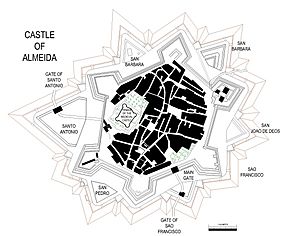Siege of Almeida (1810) facts for kids
Quick facts for kids Siege of Almeida 1810 |
|||||||
|---|---|---|---|---|---|---|---|
| Part of Peninsular War | |||||||
 The Fortress of Almeida |
|||||||
|
|||||||
| Belligerents | |||||||
| Commanders and leaders | |||||||
| Strength | |||||||
| 18,000 men | 6,000 men | ||||||
| Casualties and losses | |||||||
| 700 | 6,000 174 guns |
||||||
The Siege of Almeida was an important battle that happened in Portugal during the summer of 1810. It was part of a bigger conflict called the Peninsular War, which was itself part of the Napoleonic Wars. In this siege, French soldiers led by Marshal Michel Ney attacked and took over the strong border fortress of Almeida. The fortress was defended by Portuguese soldiers under Brigadier General William Cox. Almeida is a town in eastern Portugal, very close to the border with Spain.
Why Almeida Was Important
Almeida was a very important fortress. It was located on a main path that the French army used to invade Portugal. This path went from Ciudad Rodrigo in Spain all the way to Lisbon, the capital of Portugal.
A large French army of 65,000 soldiers, led by Marshal André Masséna, surrounded Almeida. This was part of France's third attempt to invade Portugal. Just the day before, French forces had pushed back the British and Portuguese armies at the Battle of the Côa.
The British-Portuguese army, with about 50,000 soldiers, was led by General Lord Wellington. They were on the other side of the Coa River. The river banks were very steep, and there were only two bridges. The French army guarded these crossings. This meant the British and Portuguese could not cross the river to help the soldiers inside Almeida.
The Siege Begins
The French army had just successfully taken Ciudad Rodrigo. They then began their attack on Almeida on July 25, 1810.
Inside the fortress, Brigadier General William Cox commanded about 4,000 Portuguese soldiers. These included three groups of local fighters called militia. There were also some regular British soldiers, including 1,200 men from the 24th Line Regiment. A group of 1,200 cavalry soldiers and over 400 gunners (soldiers who operate cannons) were also present.
The defenses of Almeida were in much better shape than those of Ciudad Rodrigo. Almeida had over 100 cannons. Forty of these were very powerful 18-pounder guns or even heavier. Most of these cannons were protected inside strong stone rooms called casemates.
The French attack was carried out by their VI Corps. This force included 14,000 infantry (foot soldiers), 1,000 cavalry (soldiers on horseback), and 1,000 artillerists. They also had 100 cannons. This group was led by Marshal Michel Ney. Another French force, the VIII Corps, led by General Jean-Andoche Junot, was waiting nearby as a backup.
The Bombardment and Explosion
The French received their supplies for the siege from Ciudad Rodrigo on August 15. They started digging trenches to the southeast of Almeida. These trenches faced a part of the fortress called the San Pedro bastion. The French had many cannons for the siege. They used their own guns and also cannons they had captured from the Spanish at Ciudad Rodrigo.
By August 24, the French had set up eleven cannon batteries. These batteries had over 50 cannons ready to fire. The Portuguese defenders fired back at the French, but their shots did not do much damage.
The main French attack began on August 26 at 6 AM. Many parts of the town quickly caught fire. The cannons in the closest three Portuguese batteries were quickly overwhelmed. However, the rest of Almeida's defenses held strong.
The governor of Almeida felt confident that they could hold out. But then, a French cannonball made a very unlucky hit. The main gunpowder storage area in the castle had been used all day to supply the defenders. At some point, a leaky barrel of gunpowder had left a trail of powder leading to the courtyard.
Around 7 PM, a French cannonball landed in the courtyard. It ignited the gunpowder trail, which led through an open door into the magazine. This caused a huge chain reaction. The explosion killed 600 defenders and wounded 300 more. The castle where the gunpowder was stored was completely destroyed. Parts of the fortress walls were also badly damaged. A large crater from the explosion can still be seen today.
After this terrible explosion, the Portuguese soldiers had no gunpowder left to fire their cannons. General Cox had no choice but to surrender the next day. The French army took control of Almeida and its 100 cannons. The French lost 58 soldiers killed and 320 wounded during the siege. The next big battle in the war was the Battle of Bussaco.
See also
- List of the largest artificial non-nuclear explosions

